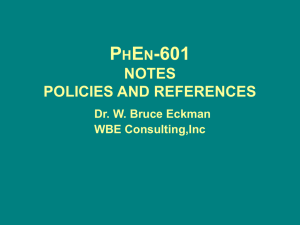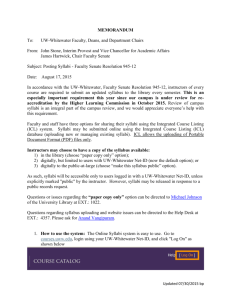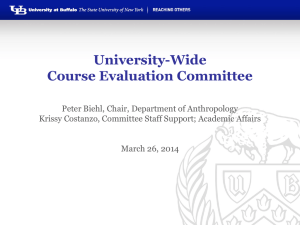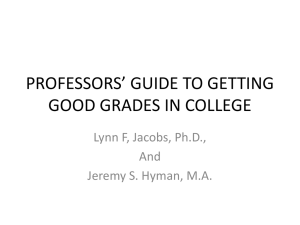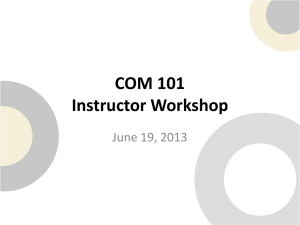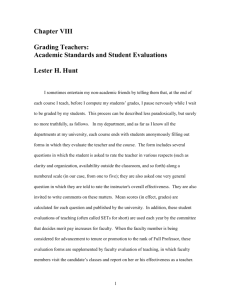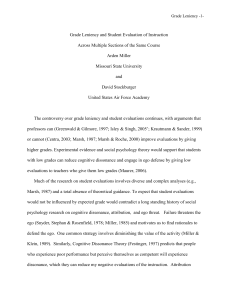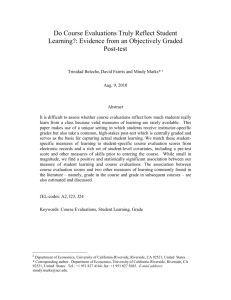Teaching-related Policies at UIC
advertisement
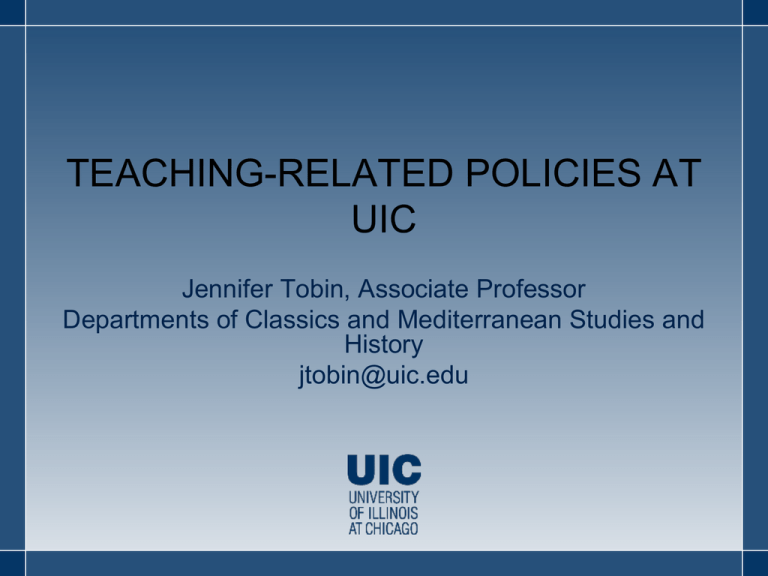
TEACHING-RELATED POLICIES AT UIC Jennifer Tobin, Associate Professor Departments of Classics and Mediterranean Studies and History jtobin@uic.edu SYLLABUS GUIDELINES http://www.uic.edu/depts/oaa/ua/syllabus_policy.html • Required for all courses • Collected every semester by the instructor’s home unit • First point of communication with students • Roadmap for your course Studies indicate: The more explicit the syllabus is in objectives, content, instruction resources and grading components, the better the student performs. Serafin (1990) Competency based syllabi in which student competencies to be developed were outlined and explained resulted in improved student performance. Kern (1990) Course Goals • Address your students in the first person • State the course goals in terms of what students can do (leads to specifics that students can interpret) • Be excited about your material COURSE DESCRIPTION (old) This course is designed to familiarize the student with the art, architecture, history and culture of Ancient Egypt, from Predynastic times in the 4th millennium BC through the end of the New Kingdom (ca. 1000 BC) COURSE DESCRIPTION (new) In this course you will study the art, architecture, history and religion of Ancient Egypt, from its origins in Predynastic times in the 4th millennium BCE through the end of the New Kingdom in 1000 BCE. You will learn what elements unified the nation and made it the foremost society in antiquity, and what pressures ultimately destroyed it. In between you will study such topics as how the pyramids were built, why Hatshepsut, a female pharaoh, dressed like a man, and what really killed King Tut. The ultimate goal of this class is to train you to think like an archaeologist, to use assessment tools to understand how and why artifacts and architecture were created and what role they played in Egyptian society. Ideally you will leave this course with a deep appreciation of the achievements and challenges of the ancient Egyptians; in essence you will have learned to think like an Egyptian. Course Policies • • • • Attendance and tardiness Late/missing work and missed exams Student Courtesy suggestions Computer use, eating in class, etc. Tone: • Punitive vs. Rewarding • Use of positive motivators • Providing pedagogical rationales for policies Studies indicate: Classroom incivilities such as tardiness, inappropriate cell phone and computer use and others are linked to the absence of positive motivators by the instructor Boice (1998) Students encountering syllabi using a punitive tone are less likely to ask for help from the instructor……. 1st and 2nd–year students are particularly sensitive to the wording of syllabi Ishiyama and Hartlaub (2002) Examples Punitive: If for some substantial reason you cannot turn in your papers or take an exam at the scheduled time you must contact me prior to the due date, or test date, or you will be graded down 20%. Rewarding: If for some substantial reason you cannot turn in your papers or take an exam at the scheduled time you should contact me prior to the due date, or test date, or you will only be eligible for 80% of the total points. Ishiyama and Hartlaub (2002) MY ATTENDANCE POLICY (old): Attendance is MANDATORY. Role will be taken at the beginning of each class. Five or more unexcused absences will be penalized at the end of term by the final grade being dropped by ten points (the equivalent of a full grade). To have an absence excused you must present me with documentation (i.e. a doctor’s note or other official record). MY ATTENDANCE POLICY (new): Attendance is required. Because I will show you approximately 50 slides in a day and cover material that is not always found in the textbooks, it is in your best interests to attend class regularly. I will take role at the beginning of each class. Missing a class due to illness or other unforeseen circumstances will receive no penalty as long as the absence is supported by documentation (i.e. a doctor’s note or other official record). I will penalize five or more unexcused absences by dropping your final grade by ten points (the equivalent of a full grade). Methods of Evaluation • Midterm Grades • Final Examinations – Must take place during the 16th week of the semester – Dates and times scheduled by the Office of Classroom Scheduling – No formal instruction can take place during exam week Resources • • • • Undergraduate Success Center (USC) Learning Centers Counseling Services YOU Students are more likely to seek help from the instructor when she explicitly offers outside help. This is especially true when the offer appears in the syllabus. Perinne, Lisle and Tucker (1995) TEACHING EVALUATIONS Click to edit subtitle STUDENT EVALUATIONS • Required for all courses with more than 10 enrolled students • To be administered close to the end of term • Campus Service (though the Office for Faculty Affairs): students do the evaluations on-line in class or at home • The instructor’s home unit may choose to create its own set of evaluations, in either paper or electronic form • The office for Faculty Affairs will maintain electronic records of student evaluations • Instructors will also receive electronic copies Advantages • For Students – Provides a means for anonymous feedback to their instructors. • For Faculty – Mechanism to receive student feedback on course content, course process and procedures, and teaching approach. – Student evaluations are used in the tenure review process and when considering the criterion for teaching excellence PEER EVALUATIONS • Most departments require these yearly for untenured or tenure-track faculty • Senior faculty member observes a class and writes an assessment which is usually shared with the instructor • These assessments are placed in the instructor’s file Advantages • Valuable feedback from experienced faculty • Regular peer assessments can document improvement in teaching • Opportunity to show your talents in the classroom • Peer evaluations are used in the tenure review process Suggestions • Maintain your own file of evaluations (both electronic and letters from peer reviewers) • Consider inviting a member of another related department to assess your teaching MIDTERM GRADES AND FEEDBACK http://tigger.uic.edu/depts/oar/uic_faculty_staff/grades/midter m_grading.html#reports • Highly encouraged for 000 and 100-level courses • Midterm grades can be entered on the Banner Class Roster during a one-week period mid-semester • Grades are not recorded on the student’s permanent record • Students can view midterm grades via my.uic.com • Advisors can also see these grades Advantages • For Students – Provides them with feedback on where they stand in the course • For Advisors – Mechanism that allows advisors to reach out to students who appear to be struggling • For Faculty – Means to recognize a student in trouble Suggestions • Schedule several assessments (tests, writing projects, homework assignments) before the middle of the semester • Publish midterm grades in 200-level and above courses on Blackboard or your class website • Explain to your students how their midterm grade might predict their final grade • Encourage students at risk to visit you in your office hours Bibliography Ambrose, S.A. et al.(2010), How Learning Works: 7 Researchbased Principles for Smart Teaching. San Francisco, CA: Jossey-Bass Publications Boice, R. (1998). Classroom incivilities. In K.A. Feldman & M.B. Paulson (Eds), Teaching and learning in the college classroom. Needham Heights, MA: Simon & Schuster Custom Publications Ishiyama, J., and Hartlaub, S. (2002). Does the wording of syllabi affect student course assessment in introductory political science classes? PS: Political Science and Politics, 567-570 Kern, R. 1990. “Use Of Competency-Based Course Syllabus and Its Effects on Student Performance in Introductory Computer Courses.” Community/Junior College Quarterly of Research and Practice 14:115–22. O’Brien, Judith Grunert et al. (2008), The Course syllabus: A Learning-Centered Approach, San Francisco, CA: Jossey-Bass Publications Perrine, Rose M., James Lisle, and Debbie L. Tucker. 1995. Effects of a Syllabus Offer of Help, Student Age, and Class Size on College Students’ Willingness to Seek Support from Faculty. The Journal of Experimental Education 64:41–52. Serafin, Ana Gil. 1990. Course Syllabi and Their Effects on Students’ Final Grade Performance. Bloomington: Indiana University, ERIC Clearinghouse for Social Studies/Social Science Education, ERIC: ED328202
